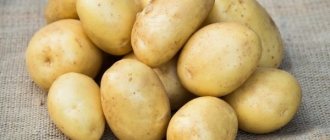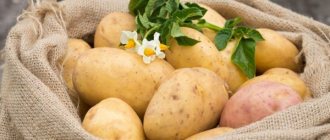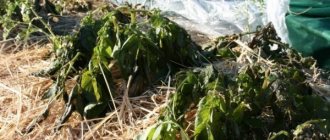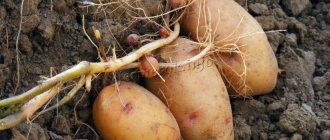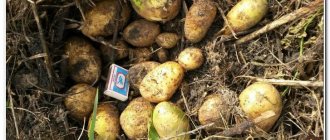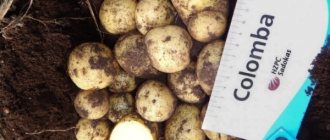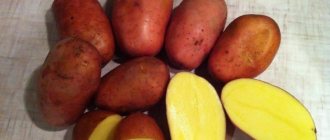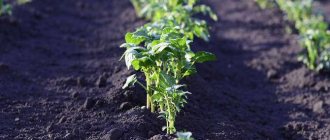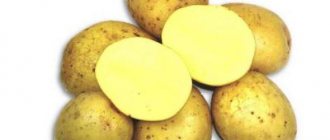Main characteristics
Potatoes belong to the “pink” varieties of very early ripening. It produces good harvests in almost any weather conditions. Moreover, you can harvest potatoes a couple of months after the first shoots.
The bush is semi-spreading, medium height. There are not many stems, but they branch well. The leaves are dark green and large. Flowering is short but rich, with flowers having a red-violet color. The inflorescences are very small and do not set fruit. Each bush can produce about 10 tubers.
Zhukovsky has good resistance to most typical potato diseases.
This variety has amazing resistance to drought or cold. It is often necessary to plant at a time when constant weather has not yet established, but the plant can survive in such conditions. Several missed waterings will also not affect the crop.
Reviews of early potatoes Zhukovsky
Oleg Viktorovich, 43 years old, Belgorod
Potatoes of the Zhukovsky variety were planted with seedlings in beds under film. However, after a while there was no flowering. I tried to dig it up and it turned out that the root crop looked old. The peel can no longer be scratched; it is all cracked. The fruits are all huge. The taste is watery, both fried and boiled. I just kept the potatoes too long, although I was waiting for them to bloom. As a result, we never tasted the new potatoes. In general, the Zhukovsky early variety is not bad, I recommend it.
Anna Alekseevna, 51 years old, Orel
This year we dug up Zhukovsky potatoes. All one in one: even, smooth, pink. The presentation is excellent. I also like the taste. There is a sweetish aftertaste. But it is more suitable for frying because it does not disintegrate. Resistance to late blight disease is weak, although this is indicated in the characteristics of the variety. Let's see how it sits. We want to leave them for planting and then breed them later.
Description of fruits
The root vegetables look pretty neat. They have pink skin that is smooth and thin. Potatoes with a pronounced red hue are also acceptable. The approximate weight of the tuber is 150-170 grams, the shape is uneven. During cooking, it does not lose its structure and does not become overcooked. The eyes are small, there are few of them, scattered over the entire surface. The pulp is white; if you cut the root vegetable, it will not darken. A positive feature is that potatoes are resistant to various damages. It does not lose its product characteristics even when transported over long distances.
According to its cooking characteristics, Zhukovsky belongs to types A/B (salad, universal).
As for nutritional value, potatoes contain about 15% starch, a lot of vitamins and other useful elements. Experts call the root vegetables of this variety a complete source of protein and minerals. The calorie content is not the highest, and it contains very little fat and cholesterol.
Productivity
According to agronomists, the yield of the variety in the Central region of Russia is approximately 145-324 kilograms per 100 square meters. The maximum recorded figure is 380 kilograms. Experienced summer residents say that if the potatoes are provided with very good conditions, they will produce up to 600 kilograms. It is quite possible to get more than 10 tubers from one plant bush.
If we talk about yield indicators on farms, they are approximately 600 centners per hectare.
Diseases and pests
Due to the hard work of breeders, Zhukovsky potatoes have good immunity. Most diseases characteristic of nightshades do not affect it. At the same time, experts emphasize the questionable resistance of the variety to late blight. True, the harvest is usually harvested before mid-July, so the likelihood of encountering this disease is low.
There is a possibility of cancer. The disease is extremely dangerous because it destroys the entire crop. The plant is covered with specific growths that look like cauliflower inflorescences. To prevent the occurrence of the disease, it is recommended not to plant potatoes in one place for more than 4 years in a row. It is also very important to remove weeds. You should not plant nightshade plants in infected areas. Any affected individuals should be removed and burned immediately. Quarantine for cancer-prone crops in the affected area is 3 years.
Sometimes potatoes suffer from Alternaria blight. It appears as brown and brown spots on the foliage. To combat this disease, it is recommended to constantly remove weeds, plant only healthy individuals, and also use special chemicals (Baktofit, Integral, Skor).
In addition, the plant may suffer from aphids or wireworms. To combat them, mainly traditional methods of treatment are used: soap solution or onion tincture (for aphids). From the wireworm, onion or garlic peels are placed at the bottom of each planting hole.
Wireworm
Colorado beetle
Medvedka
The main and most dangerous pests for potatoes are the Colorado potato beetle and mole cricket. For the Colorado potato beetle, it is best to use special chemicals according to the instructions. If the parasite has not yet captured the entire plant, it is advisable to remove it from the bushes and burn it. The mole cricket is scared away or destroyed.
The variety is also susceptible to attacks by potato nematodes. This is a parasitic worm that causes potato growth to stop. Sometimes the harvest practically disappears and becomes of poor quality. Certain types of parasite can infect roots. For prevention, it is recommended to constantly treat the area with insecticides, as well as immediately remove and dispose of weeds. If any twig or leaf looks suspicious, you need to immediately remove this part of the plant. If you suspect a nematode, you should stop watering from above. Moistening is allowed only for the root system.
Advantages and disadvantages
Of course, it is very important to consider the advantages and disadvantages of a crop before planting it on your site. Zhukovsky has significantly more positive traits than negative ones.
Advantages:
- Plant resistance to adverse weather conditions: drought or cold. It can also withstand temperature changes.
- The tubers ripen early and quickly.
- The presentation of root crops is attractive; it remains so even after long-term transportation.
- The harvest is not afraid of damage.
- Pleasant taste of potatoes, which do not become soft when cooked. Low calorie content, good composition.
- Excellent immunity to most diseases.
- Productivity always remains at a stable level.
- Fruiting is extended.
Flaws:
- Insufficiently high resistance to late blight.
- The taste is still not ideal, there are better varieties.
- If the soil is too wet, the roots will begin to rot.
- When harvesting is delayed, it loses its taste.
Harvesting and storage
Potatoes "Zhukovsky" ripen 60 days after planting. The variety is highly resistant to mechanical damage, making it possible to harvest using automatic devices.
Potatoes are stored in a dark room at a temperature of +2-5 degrees. When the temperature rises, the potatoes will begin to sprout; when the temperature drops, they freeze, spoil, and their taste deteriorates. It is better to place root vegetables in wooden boxes or bags. Read more about proper storage of potatoes here.
Landing
Seed potatoes are usually prepared for cultivation. The tubers are carefully crushed, separating healthy individuals from sick ones, and germinated.
You should not take root crops that are too small (less than 80 grams) for planting, or material that is too soft in structure.
You should not cut the tubers for hanging planting material, as this will negatively affect the characteristics of the variety during cultivation.
After this, the tubers are placed for germination. For this purpose, use boxes, bags, or simply lay out the material in bulk under the film. The temperature should be kept at a level from +4 to +20, lighting should be diffused. To do this, cover the potatoes with a white cloth, paper or newspapers. If germination takes place indoors, it is important to carry out periodic moistening and turning, as well as disinfection with potassium permanganate (once a week).
When sprouts about a centimeter long appear on the tubers, you can start planting. When planting by hand, you can reduce the ripening period of the variety by immersing the tubers in peat or wet sawdust. A week before planting, it is worth digging up the soil. The composition of the soil is not important. Planted at medium length and with medium density, cover the plantings with agrofibre. You can place garlic or onion peels at the bottom of the holes to repel parasites.
Storage
The description of the potato variety Zhukovsky early and the reviews of experienced gardeners agree on one thing - after harvesting, the tubers must dry out. The minimum period is 4 hours. Afterwards, the root crops are carefully sorted and placed in boxes.
It is recommended to choose dark, dry, well-ventilated rooms for long-term storage. Temperature parameters in the first 14 days should be within + 16-17 °C. Afterwards, set constant indicators at + 2-5 ° C and air humidity 80%.
Care
There is nothing complicated about caring for this variety. Important activities are the following:
- Weeding between rows and loosening the soil. It is very important to remove weeds as soon as they appear. Loosening allows air to penetrate deeper into the soil, which has a beneficial effect on the development of the crop.
- Comprehensive pest protection. It is very important to repel the Colorado potato beetle and mole cricket from potatoes.
- Watering. Although the variety is drought-resistant, it still needs watering. It can be moderate, but in hot weather conditions it is recommended to apply 5 liters per linear meter of bed.
- Hilling. It is carried out several times a season: first during the flowering process, and then as needed.
- Potatoes can be harvested 2 months after planting. By the end of July, you need to cut off all the tops, which protects against phytosporosis.
Planting and caring for Zhukovsky seed potatoes
It is preferable to plant early Zhukovsky potatoes in sunny areas. They should be flat, which will eliminate the possibility of even short-term flooding. There are no special requirements for the composition of the soil. However, it will grow better in light, fertile, sandy or loamy soils. After all, this soil is able to maintain a loose structure for a long time and not interfere with the access of oxygen to the roots.
Selection and preparation of a landing site
The place in the garden for Zhukovsky potatoes is dug up 2 times a year - in autumn and spring.
The procedure, carried out in cold weather, involves getting rid of possible infectious pathogens overwintering in the soil. There is no need to break the rough lumps during the process; let them freeze. Manure is added to increase soil fertility. It is scattered throughout the territory, the application rate is 5 kg per 1 sq. m. m. This contributes to the appearance of beneficial microflora in the garden bed.
The spring procedure is more superficial. Digging is carried out when the surface layer dries, earth blocks and lumps are broken up, making the bed level. The maximum digging depth is 15 cm. During the process, weed roots and pest larvae are removed. Then you can sprinkle nitrogen fertilizers on the surface of the soil.
To obtain constant and abundant harvests of Zhukovsky potatoes, it is necessary to adhere to correct crop rotation. It is optimal to plant the crop after carrots, beets, cucumbers, and cabbage. It is not recommended to plant Zhukovsky potatoes after eggplants, tomatoes, and peppers. Because they have common diseases and pests.
In addition, experienced gardeners do not recommend placing Zhukovsky potatoes in one area for more than two years; the soil needs rest.
Preparation of planting material
The yield of the crop directly depends on the quality of early Zhukovsky seed potatoes. For planting, you should choose healthy, oblong tubers weighing 100–150 g.
As a rule, sprouted potatoes appear 10–14 days earlier. Therefore, it is necessary to prepare planting material a month before planting.
- They are treated against diseases and pests with the drug Maxim.
- Transfer Zhukovsky potatoes to a room with a temperature of + 10-13 °C.
- Lay out the root vegetables on racks or in boxes in one layer.
- They are constantly inspected and rotten specimens are removed.
- Potatoes are ready for planting if the sprouts have reached 1 cm or more.
- To reduce germination time, you can plant the fruits in a peat mixture with periodic spraying with water.
To increase germination and ensure immunity, Zhukovsky potatoes should be kept in bright light for 7-10 days until the skin turns green. Sprouted root vegetables must be planted manually to avoid breaking off the sprouts.
Landing rules
Early Zhukovsky potatoes are planted in open ground at the end of April or at the beginning of May, depending on the region. The soil should still be moist so that the spade bayonet easily sticks together into a lump and does not crumble.
The standard planting scheme is suitable for this variety - the distance between the tubers is 25-30 cm, and the row spacing is 60 cm. The depth is 10 cm; if there is a lot of clay in the soil, it is better to reduce it. Plant in even rows, under a cord. This will make it easier to care for the crop in the future.
Watering and fertilizing
There is no need to water Zhukovsky potatoes during growth if they are planted in moist soil and it rains regularly. However, the condition of the soil must be kept under control. In hot weather, a layer of mulch will help retain moisture between the rows.
As a rule, Zhukovsky potatoes are watered early in the morning or in the evening. It is better not to perform the procedure during active sunshine. The first procedure is carried out after germination. The volume of liquid is 2-2.5 liters per bush. With a lack of moisture during this period, a large number of stolons develop, and the number of tubers decreases.
The second necessary procedure is carried out during the budding and flowering of early Zhukovsky potatoes. It will be enough to pour 4 liters of water under the bush. If this is not done, and the plant will lack water, the tubers will be small.
Early varieties need to be fed a little earlier than others.
- Nitrogen-containing substances are added in the spring, during preparatory excavation work or directly into the planting hole.
- During flowering, Zhukovsky potatoes need potassium. For 10 liters of water you will need a matchbox of potassium sulfate. Mineral fertilizing is applied after watering or rain. You should pour 1.5 liters of useful liquid under the bush.
- The most effective fertilizers for Zhukovsky potatoes are organic matter, in particular bird droppings. It cannot be used in its pure form. Therefore, organic fertilizer is diluted with water in a ratio of 1:15, respectively. For one plant, 1 liter will be enough. Such fertilizing can protect bushes from fungal infections, since after application beneficial microorganisms develop in the soil.
- Once the tops dry out, it is no longer useful to feed them.
Loosening and weeding
The procedure for loosening the soil is carried out after rain or watering. In a long spring, when there are no shoots for a long time, loosening accelerates the emergence of shoots. The process has a positive effect on the development of tubers. For preventive purposes, loosening helps to avoid fusarium or bacterial rot and late blight. It is important to remember that the loosening depth should be 3-5 cm.
A mandatory rule is also the regular removal of weeds from the Zhukovsky potato bed. Because they interfere with the growth of tubers. In addition, weeds are carriers of dangerous diseases.
Hilling
During the entire growing season, the procedure is carried out twice. For the first time, Zhukovsky potato sprouts will be visible 10-15 cm from the surface of the earth. Hilling is especially important for areas where recurrent frosts are possible. The soil should be raked so that the plants remain 5 cm high. The procedure should be repeated after 2-3 weeks if the soil is wet. If not, then you should water it first.
Hilling up potatoes Zhukovsky stimulates the timely development and ripening of tubers.
Reviews
Natalya, Minsk : A neighbor advised me to grow this variety because I could not find a suitable potato for my plot. She even gave me a few tubers to plant. Zhukovsky really made me happy. It produces a harvest very early, and the taste of the root crops is quite pleasant. And the potatoes were stored for a very long time, since we collected so much of it that it was impossible to eat right away. In general, from now on I will only grow this variety.
Valery, Saratov : Amazing variety. You can collect it very early; we already finish harvesting by July. I would like to note that from several bushes we get so many potatoes that we then eat them for several months. By the way, the fruits tolerate transportation well and are not damaged. The taste is good, although there are better varieties, but for me they are more problematic to grow.
Lyudmila, Zubtsov : My family is delighted with these potatoes. She is very gentle and sweet. We have been growing only the Zhukovsky variety for a long time, we are completely satisfied with it in everything. The only thing is that you have to replant it every few years, otherwise the characteristics noticeably deteriorate. But the plant is generally unpretentious in care. Ideal for people who cannot devote much time to the garden.
